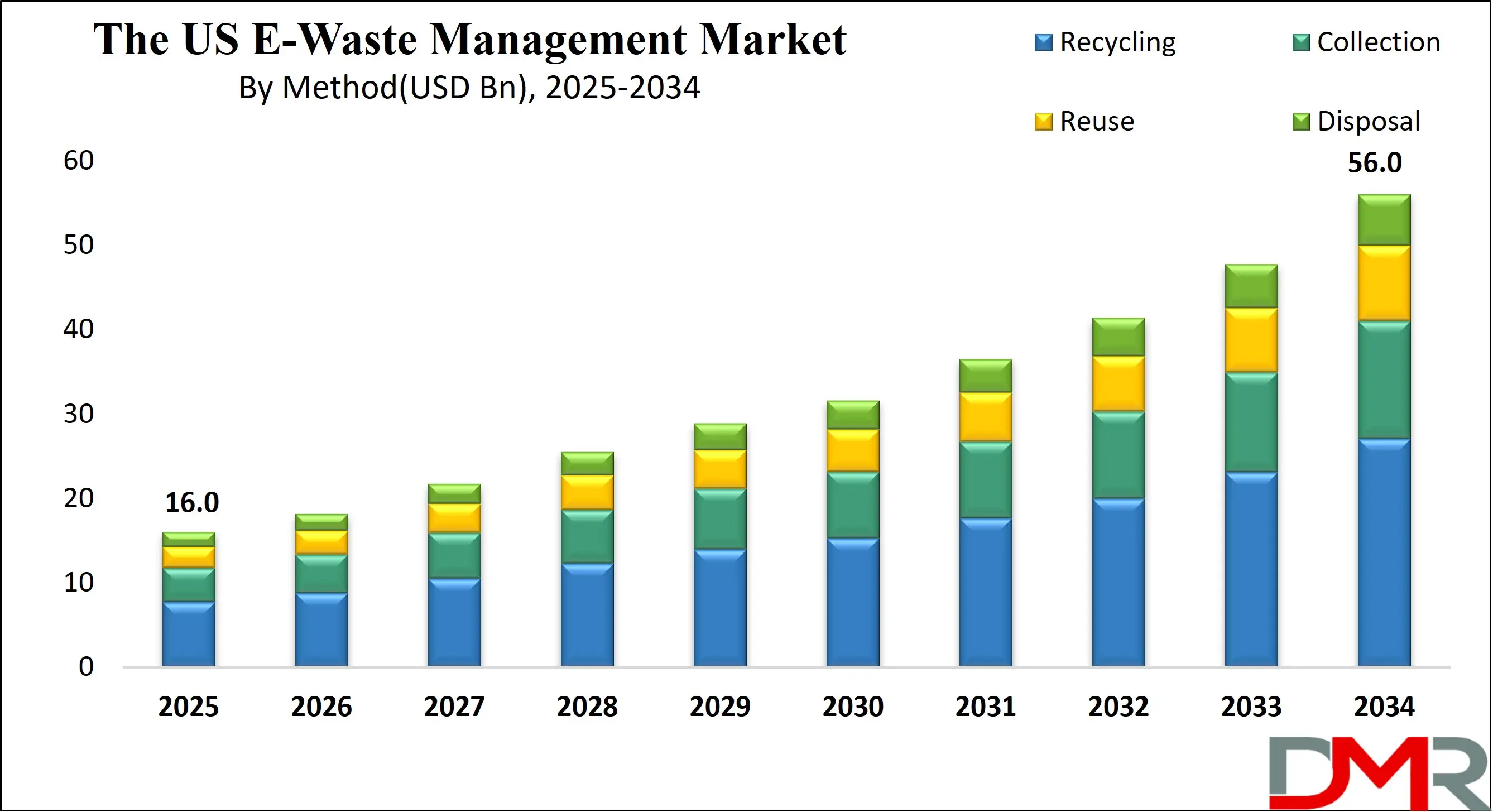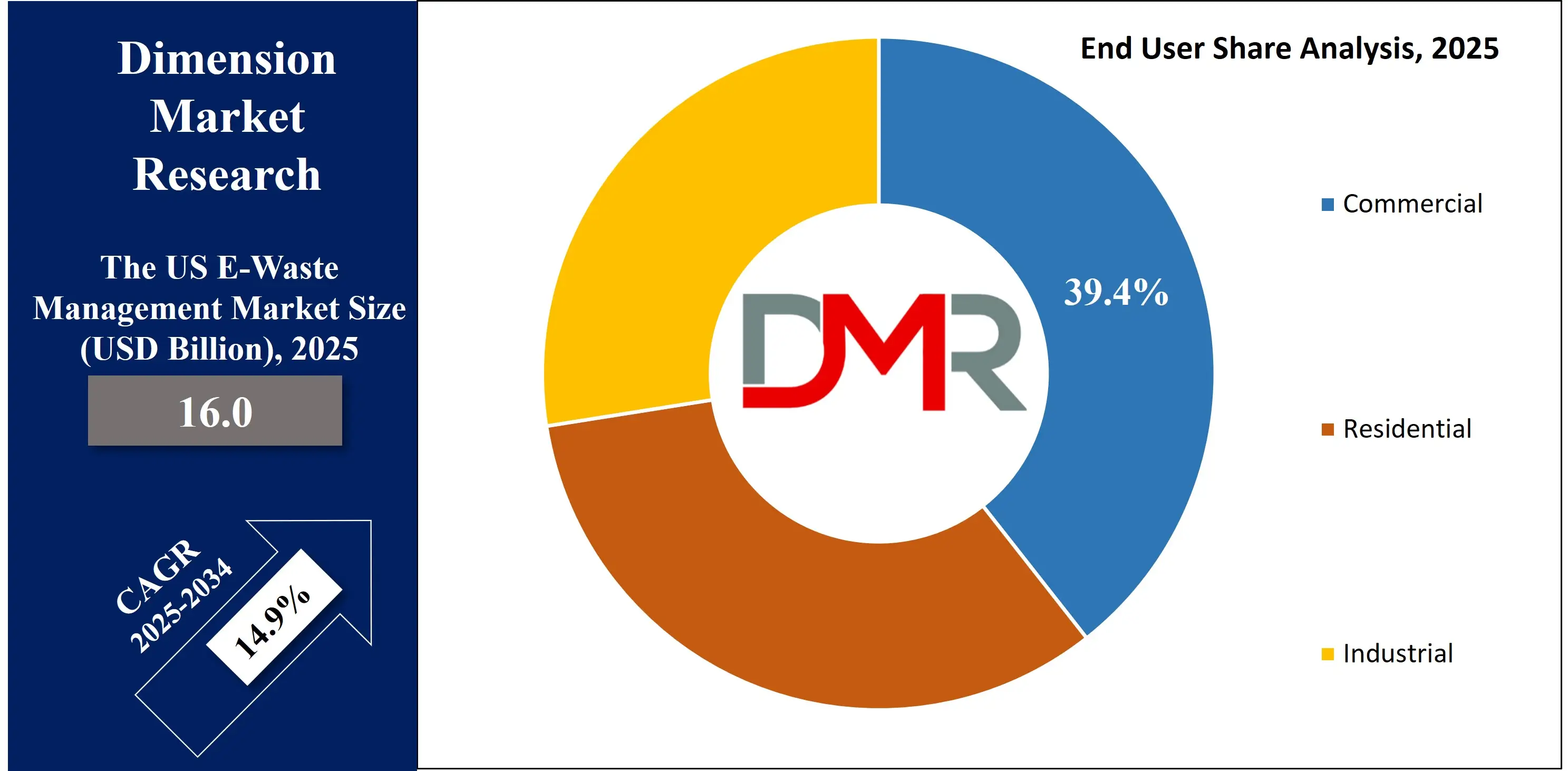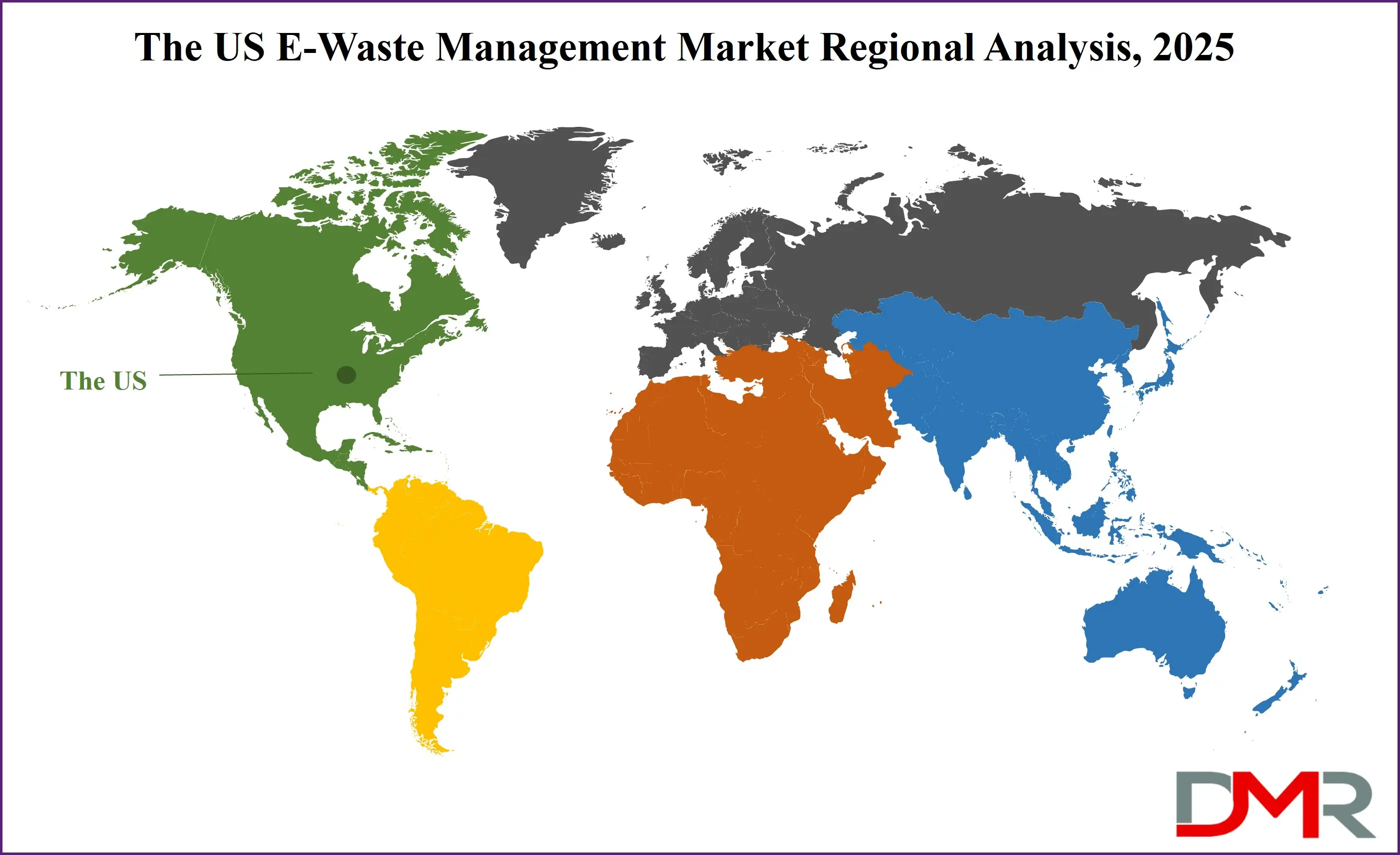E-waste management in the United States refers to the process of collecting, recycling, refurbishing, and properly disposing of discarded electronic devices. This includes items like computers, phones, TVs, printers, and other digital gadgets that have reached the end of their useful life. As technology advances quickly and people upgrade devices more often, the amount of e-waste is rising rapidly. Managing this waste is important to reduce pollution, protect health, and recover valuable materials such as metals and plastics.
In recent years, the demand for proper e-waste handling has grown because more households and businesses are generating electronic waste. With the rise of work-from-home culture, online schooling, and digital tools, the usage of electronics has increased. As a result, more old devices are being thrown away. The growing awareness of environmental harm caused by e-waste has also pushed companies and governments to take action. People now care more about where their old electronics go and how they affect the environment.
Several trends have emerged in the U.S. e-waste sector. One trend is the rise of take-back programs by manufacturers and retailers, which encourage customers to return their used devices for proper recycling. Another trend is the growth of certified e-waste recyclers who follow safe and responsible recycling practices. Many companies are now also focusing on refurbishing old electronics to extend their life instead of destroying them. At the same time, states are working to create or improve e-waste recycling laws to increase collection and reduce dumping.
Some key events have influenced the U.S. e-waste landscape in recent years. A number of states have introduced or updated laws requiring electronics producers to manage or finance the recycling of their products. Also, several enforcement actions have taken place against illegal dumping or exporting of e-waste. Companies have been held accountable for not following proper recycling rules, and this has led to stronger regulations and better practices in the industry.

Another important change is the growth of public-private partnerships in e-waste management. Many recycling companies now work with cities, schools, and community centers to host collection events. These events make it easier for people to safely dispose of electronics. Some tech firms have also invested in recycling technologies that separate and reuse rare materials, reducing the need for mining and helping the environment.
The US E-Waste Management: Key Takeaways
- Market Growth: The US E-Waste Management Market size is expected to grow by USD 37.8 billion, at a CAGR of 14.9%, during the forecasted period of 2026 to 2034.
- By Method: The Recycling segment is anticipated to get the majority share of the US E-Waste Management Market in 2025.
- By Application: The Commercial segment is expected to get the largest revenue share in 2025 in the US E-Waste Management Market.
- Use Cases: Some of the use cases of E-Waste Management include public collection events, retail take-back programs, and more.
The US E-Waste Management: Use Cases:
- Corporate IT Asset Disposal: Large companies regularly upgrade their IT equipment and need secure disposal of outdated devices. E-waste management services ensure data destruction, proper recycling, and compliance with environmental laws. This helps businesses reduce liability and improve sustainability.
- Public Collection Events: Cities and local governments often organize e-waste drives for residents to drop off old electronics. These events make it easy for the public to recycle responsibly and keep harmful materials out of landfills. It also raises awareness about proper disposal methods.
- Retailer Take-Back Programs: Many retailers offer take-back or trade-in programs for used electronics. These services allow customers to return old devices in-store or by mail. Returned items are then refurbished or recycled safely.
- Electronics Refurbishment and Resale: Some e-waste firms focus on refurbishing devices for resale, especially phones, laptops, and tablets. This gives electronics a second life and makes tech more affordable. It also reduces the volume of waste entering recycling centers.
Market Dynamic
Driving Factors in the US E-Waste Management
Regulatory Push and Extended Producer Responsibility
Stronger environmental regulations are a major growth driver in the U.S. e-waste management market. Laws at state and federal levels now require electronics producers to take responsibility for end-of-life disposal, a model known as Extended Producer Responsibility (EPR). This encourages manufacturers to design products that are easier to recycle and ensures they help fund recycling programs. In many areas, consumers can’t discard electronics in regular trash, which boosts demand for efficient collection and processing systems. As compliance costs rise and penalties for improper disposal increase, more companies are investing in responsible recycling infrastructure. These factors are fueling industry growth and innovation in managing electronic waste
Technological Innovation and Circular Economy
Advances in recycling technology and the shift toward a circular economy are another key growth driver. New methods—such as hydrometallurgical recovery, AI-driven sorting, and robotics—improve the efficiency and yield of valuable materials like gold and rare earth metals from old electronics. These technologies reduce environmental impact and recovery costs. At the same time, businesses and consumers increasingly prefer solutions that reuse, refurbish, or recycle devices, keeping materials in use longer. This mindset shift, combined with improved recycling tech, is enabling more sustainable and cost-effective e-waste services.
Restraints in the US E-Waste Management
Limited Public Awareness and Collection Infrastructure
One key challenge for the U.S. e-waste management market is the lack of widespread public knowledge and collection facilities. Many people still don’t know how or where to properly recycle electronics, leading to low participation in take-back programs. Rural and underserved areas often lack convenient drop-off locations, so residents may just throw devices in household trash. Without increased access to local collection points and strong public education campaigns, recycling rates remain low—even as device usage grows. Overcoming this requires sustained outreach, more collection events, and infrastructure expansion in both urban and rural communities.
High Collection and Processing Costs
Another major restraint is the expensive and complex nature of e-waste operations. Collecting, transporting, and safely handling electronics—especially bulky or hazardous items—requires specialized equipment and facilities. Processing systems must manage materials like lead, mercury, and plastics in line with strict regulations. Without enough volume, many recycling centers struggle to cover these operational costs. As a result, some regional operators may scale back or close, creating service gaps. Reducing costs will require improved logistics, economies of scale, and better incentives to ensure continuous, efficient operations across the country.
Opportunities in the US E-Waste Management
Growth in Refurbished Electronics Market
The rising demand for affordable electronics presents a major opportunity for the U.S. e-waste management market. Refurbishing and reselling used devices not only reduces environmental impact but also makes technology more accessible to budget-conscious consumers. Educational institutions, startups, and developing markets are increasingly turning to refurbished electronics as a cost-saving option. E-waste firms that can efficiently test, repair, and certify used devices stand to benefit from this expanding segment. As sustainability becomes a priority, more companies are adopting buy-back and resale programs, further boosting the refurbished market. This approach also supports job creation in repair and logistics, creating a positive ripple effect across industries.
Partnerships with Tech and Retail Sectors
Collaborating with electronics manufacturers and retailers offers a strong opportunity to expand e-waste collection and recycling services. Many brands are actively seeking partners to manage their product take-back and recycling programs as part of their sustainability goals. By aligning with major tech firms and retail chains, recycling companies can gain access to a larger volume of used electronics and reach more consumers. These partnerships can also support innovation in tracking, traceability, and material recovery. Additionally, joint efforts in public education and promotion can improve participation rates in e-waste recycling, strengthening the overall ecosystem and driving long-term growth.
Trends in the US E-Waste Management
AI and Automation in Sorting and Recycling
Recycling facilities are increasingly using AI-powered robots and smart vision systems to sort electronic waste more precisely and safely. These systems help identify different materials, making extraction of valuable metals and plastics more efficient while reducing human error. By automating repetitive and hazardous tasks, recyclers can process more items at a faster pace with less labor. This trend also helps in gathering real-time data on waste streams, enabling operators to optimize their processes and improve recovery yields. As these technologies evolve, they’re becoming more accessible, giving both large and specialized recyclers a competitive edge in material recovery.
Shift Toward Circular Economy and Refurbishment
The U.S. e-waste sector is increasingly focused on keeping electronics in use longer through refurbishment and reuse. Many firms now refurbish devices like laptops and phones, extending their lifecycle and reducing waste sent to recycling centers. This shift supports a circular economy mindset—where used electronics are repaired or upgraded, then re-enter the market at lower costs. To ensure quality and transparency, automated grading and testing systems powered by AI are being adopted. These tools make refurbishment scalable and cost-effective, helping close the loop in electronic consumption and reducing the need for new device manufacturing.
Research Scope and Analysis
By Source Type Analysis
Consumer electronics will be leading the U.S. e-waste management market in 2025 with a share of 34.8%, driven by the widespread use of smartphones, laptops, tablets, televisions, and home appliances. As digital lifestyles grow and product lifecycles shorten, households continue to replace older devices more frequently. This growing stream of discarded gadgets is putting pressure on the recycling ecosystem. Easy access to newer technology and continuous product upgrades are adding to the volume of electronic waste.
Alongside this, awareness around safe disposal practices and the availability of manufacturer-led take-back programs are supporting recycling activity. With increasing digital connectivity and device ownership per person, consumer electronics remain the primary contributor to e-waste volume. Their sheer diversity and rising turnover make them a core focus for collection, reuse, refurbishment, and responsible material recovery across the country.
IT & Telecom equipment will have significant growth over the forecast period as enterprises modernize infrastructure and cloud services expand. Data centers, office systems, network routers, telecom servers, and storage hardware are frequently replaced to keep up with higher performance and energy efficiency standards. This leads to a rising flow of outdated or decommissioned equipment. With growing data security concerns, secure e-waste disposal and certified destruction of IT assets are becoming more important.
Many companies are also embracing circular economy practices by partnering with recyclers for recovery and reuse of components. As digital transformation accelerates across sectors, the volume of e-waste from IT & telecom sources will continue to increase. The segment’s growing contribution reflects both corporate responsibility efforts and demand for sustainable disposal of high-tech infrastructure.
By Method Analysis
Recycling will be leading the U.S. e-waste management market in 2025 with a share of 48.3%, driven by growing efforts to recover useful materials from discarded electronics. As more devices reach end-of-life, recycling has become the most preferred method for handling large volumes of electronic waste. It helps reduce landfill use, minimizes environmental harm, and allows valuable metals like copper, gold, and rare earth elements to be reused in new products. With support from state regulations, recycling centers are expanding operations and investing in advanced sorting and processing technologies.
Public awareness campaigns and manufacturer take-back programs are also encouraging more responsible disposal. The rising volume of consumer electronics and IT equipment has made recycling a key pillar in the effort to manage e-waste effectively while promoting a cleaner and more circular economy.
Reuse is having significant growth over the forecast period as more individuals and organizations embrace the idea of extending the life of electronics. Rather than discarding working devices, many are choosing to refurbish and resell or donate items like laptops, phones, and monitors. This shift not only helps reduce e-waste but also offers affordable tech options for schools, low-income families, and small businesses.
Growing interest in sustainability, cost-saving measures, and reduced environmental impact is fueling this trend. Many e-waste firms are now focusing on repairing and upgrading devices before recycling becomes necessary. Reuse supports resource conservation by delaying the need for raw material extraction and manufacturing, making it an important part of responsible waste management strategies in the digital age.
By Material Recovery Analysis
Metals will be leading the U.S. e-waste management market in 2025 with a share of 55.1%, largely due to their high value and strong demand in manufacturing. Electronics contain important metals like copper, aluminum, gold, silver, and palladium, which can be recovered and reused through proper recycling methods. As mining for new raw materials becomes more costly and environmentally damaging, recovering metals from e-waste has become a smarter and more sustainable option.
Recycling facilities are using better separation technologies to improve metal recovery rates and reduce loss during processing. These reclaimed materials are then used in the production of new electronics, batteries, automotive parts, and industrial components. With the growing volume of discarded electronic devices, metal recovery plays a major role in resource conservation, economic return, and the long-term sustainability of the e-waste management ecosystem.
Plastics are having significant growth over the forecast period as more efforts are being made to extract and reuse these materials from old electronics. Many devices, including televisions, computer casings, and appliances, are made with plastic components that can be sorted, cleaned, and repurposed. With rising concerns over plastic pollution and landfill waste, recyclers are now focusing more on improving plastic recovery and quality.
New techniques are helping separate mixed plastics and remove toxic substances, making them safer for reuse. These recovered plastics can be used in producing new electronics, packaging, and even automotive parts. As awareness of plastic waste increases and regulations become stricter, the reuse of plastic materials from e-waste is set to play a bigger role in creating a cleaner and more circular economy.
By End User Analysis
Commercial will be leading the U.S. e-waste management market in 2025 with a share of 39.4%, as businesses across sectors generate large amounts of electronic waste from daily operations. Offices, retail stores, banks, and service providers regularly upgrade their computers, printers, monitors, and networking devices, resulting in a steady flow of outdated electronics. With increasing focus on sustainability and data security, commercial users are turning to certified e-waste recyclers to handle disposal properly.

Many companies are also adopting formal IT asset disposition policies to ensure compliance with environmental and privacy regulations. The push for digital transformation and faster tech adoption cycles means devices are replaced more often, adding to the e-waste load. Responsible recycling and reuse of this equipment not only help reduce waste but also offer cost savings and environmental benefits for commercial enterprises.
Industrial is having significant growth over the forecast period as factories, plants, and warehouses continue to modernize their equipment and automation systems. Industrial users generate a unique type of e-waste, including sensors, control panels, heavy machinery electronics, and power systems. These devices often have longer life cycles but require proper handling once retired, due to the presence of hazardous components.
The shift toward smart manufacturing and IoT-based industrial setups is increasing the use—and eventual disposal—of connected devices. With stricter environmental rules and a growing need for safe waste treatment, more industrial firms are partnering with specialized e-waste management providers. These services ensure secure disposal, materials recovery, and regulatory compliance, supporting both operational efficiency and sustainability goals in the industrial sector.
The US E-Waste Management Report is segmented on the basis of the following:
By Source Type
- Consumer Electronics
- Household Appliances
- IT & Telecom Equipment
- Industrial Equipment
- Medical Equipment
By Method
- Collection
- Recycling
- Reuse
- Disposal
By Material Recovery
- Metals
- Plastics
- Glass
- Others
By End User
- Residential
- Commercial
- Industrial
Competitive Landscape
The competitive landscape of the U.S. e-waste management market is made up of a mix of large recycling companies, small local players, and specialized service providers. These companies compete by offering different services such as safe collection, recycling, data destruction, and refurbishment of old electronics. Some focus on handling consumer electronics, while others deal with industrial or commercial e-waste.

Businesses are now also trying to offer eco-friendly and tech-driven solutions, including advanced sorting methods and better material recovery. The market is becoming more competitive due to rising awareness, government rules, and the need for sustainable waste practices. Companies that can provide reliable, safe, and efficient e-waste solutions are gaining an edge as both consumers and businesses look for trustworthy options.
Some of the prominent players in the US E-Waste Management are
- Sims Ltd
- Umicore
- Enviro-Hub Holdings
- Clean Earth
- Greentec
- Desco Electronic Recyclers
- Metech Recycling,
- Ewaste+
- Wisetek Solutions
- Ecyclers
- ECOBAT
- GEEP
- TechWaste Recycling
- eLoop LLC
- All Green Electronics Recycling
- Compucycle Inc.
- R3eWaste
- ARCOA Group
- Other Key Players
Recent Developments
- In September 2024, Cyclic Materials, an advanced recycling company focused on building a circular supply chain for rare earth elements and critical materials, has closed an oversubscribed $53 million Series B funding round. The round was led by ArcTern Ventures and joined by new investors including BDC Capital’s Climate Tech Fund, Hitachi Ventures, Zero Infinity Partners, Climate Investment, and Microsoft’s Climate Innovation Fund. Existing backers Fifth Wall, BMW i Ventures, Energy Impact Partners, and Planetary Technologies also participated in the investment.